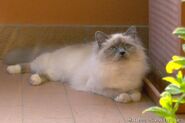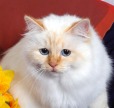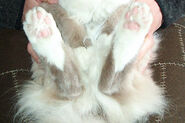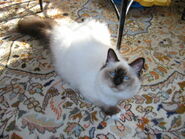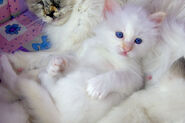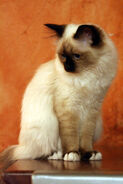| Birman | ||
|---|---|---|
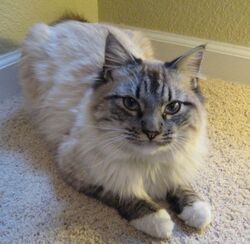 | ||
| Information | ||
| Alternative Names |
Sacred Birman, Sacred Cat Of Burma | |
| Origin |
Thought to be Burma but most probably France | |
| Breed Standard | ||
| FIFe | ||
| CFA | ||
| TICA | ||
| ACF | ||
| ACF | ||
| CCA | ||
| Cat (Felis catus) | ||
| List of Cat Breeds | ||
The Birman is a domestic cat breed. Also called the "Sacred Cat of Burma",[1] it is not to be confused with the Burmese, which is a separate and dissimilar breed. The Birman has medium-long hair, a pale colored body and darker points with deep blue eyes. Even though the cat is pointed, the paws have white gloves.
The Birman breed was first recognized in France by the Cat Club de France in 1925, then in England by the Governing Council of the Cat Fancy[2] (GCCF) in 1966 and in United States by the Cat Fanciers' Association[1] (CFA) in 1967. It is also recognized by the Canadian Cat Association (CCA), and by The International Cat Association[3] (TICA) in 1979.
History[]
While there is no clear record of the origin of Birmans, one legend is that the Birman cat originated in Burma where they were kept by temple priests in Northern Burma in the Mount of Lugh.[1] This legend is attributed to the writings of Mme Marcelle Adam (novelist and president of the Federation Feline Française and owner of Maldapour Birman Cattery) and first published by Dr. François Méry in the French Review Minerva. There are many colorful stories of how the cats first came to France, including pairs of cats being a reward for helping defend a temple, or being smuggled out of Burma by a Vanderbilt.[1][4] There is also a story that a couple of stolen birmans were imported by Thadde Haddisch.[5]
The first traces of historical Birmans go back to a Mme Leotardi[6] in the city of Nice in France.
Birmans were almost wiped out as a breed during World War II. Only two cats were alive in Europe at the end of the war, a pair named Orloff and Xenia de Kaabaa, both belonging to Baudoin-Crevoisier. The foundation of the breed in postwar France were offspring of this pair. They had to be heavily outcrossed with long-hair breeds such as Persian and Siamese to rebuild the Birman breed. By the early 1950s, pure Birman litters were once again being produced. The restored breed was recognized in Britain in 1965 and by the CFA in 1966.
The first Birman cats were seal-point. The Blue-point color was introduced in 1959 using Blue Persan lines. New colors were added by the work of English Breeders in the 1970-1980 including chocolate, red-point, and the tabby/lynx version. A Birman was also used to create new breeds like the Ragdoll cat in California.
Appearance[]
Birmans have semi-long, silky hair, a semi-cobby body and relatively small ears compared to other cat races and a Roman nose. In order to comply with breed standards, the Birman's body should be of an eggshell colour or golden, depending on the intensity of the markings colour. The markings can be pure seal, chocolate, blue, red, lilac or cream. Tabby variations are also allowed. Tortie cats can be seal, chocolate, blue or lilac. Birmans have sapphire coloured eyes.
The Birman's coat is unusual due to the white 'gloves' on each paw. They are one of the few cat breeds in the colourpoint coat that has fingers and toes in pure white colour. The genetics of this feature may not be not fully clear, though a gene conferring the white 'gloves' has been identified.
Points of Birman are: Seal-point, Blue-point, Chocolate-point, Lilac-point, Seal Tortie-point, Cream-point, Blue Cream point, Chocolate Tortie point, Lilac Tortie point. The same colours in Tabby version (Lynx): Seal Tabby point, Blue Tabby point, Chocolate Tabby point, Lilac Tabby point, Red Tabby, Cream Tabby point, Tortie Tabby point. Lynx or Red Factor colors on the legs, tail and face. The same colors exist in Silver/Smoke version while not yet recognize by all clubs. Birmans differ from conventional colour-point cats by their white paws called gloves. The coat is medium-length, not as long and thick as a Persian's, and does not mat. A notable feature is their blue eyes which remain blue throughout their life. Australian breeders have been recently working on new colors like: Cinnamon point, fawn point.
The only allowed white areas are gloves. A spot of white in another area is a fault in a Birman cat. Gloves are symmetrical in all four feet. The white must stop at the articulation or at the transition of toes to metacarpals; and all fingers must be white too. The posterior gloves on the back paws finish with an inverted V extended 1/2" to 3/4".
Birman kittens[]
All Birmans are born white (as other colourpoint kittens are) and they start developing their colours at the age of 1 week if they have a dark colour (as seal-point) and at the age of 14 days, or more, if they have a clear colour (as lilac-point). The first part which develops the colour are the points of ears, nose and tail. The real colour is complete at two years old and after a wintry season.
Birman Naming Conventions[]
Many Birman breeders follow the French tradition of assigning all kittens born in a particular year given names that begin with the same letter of the alphabet. Countries with breeders using this convention include France, UK, USA, Australia, and New Zealand.
References[]
- ↑ 1.0 1.1 1.2 1.3 Cat Fanciers Association Breed Article: The Sacred Cats of Burma Retrieved Apr 16, 2010
- ↑ Governing Counil of the Cat Fancy
- ↑ TICA. The International Cat Association. Retrieved on 2007-07-08.
- ↑ Le Chat. Races - Élevage - Maladies Paris: Vinot Frères ed. 1926, pp.40-41. Dr. Philippe Jumaud
- ↑ Les races de ChatsSaint Raphaêl: 1930: Ed. des Tablettes, pp.52 Dr. Philippe Jumaud
- ↑ Interview of Simone Poirier by Gisele Barnay Interview from the book Les Secrets du Chat Sacré de Birmanie ISBN 2-85182-335-3

